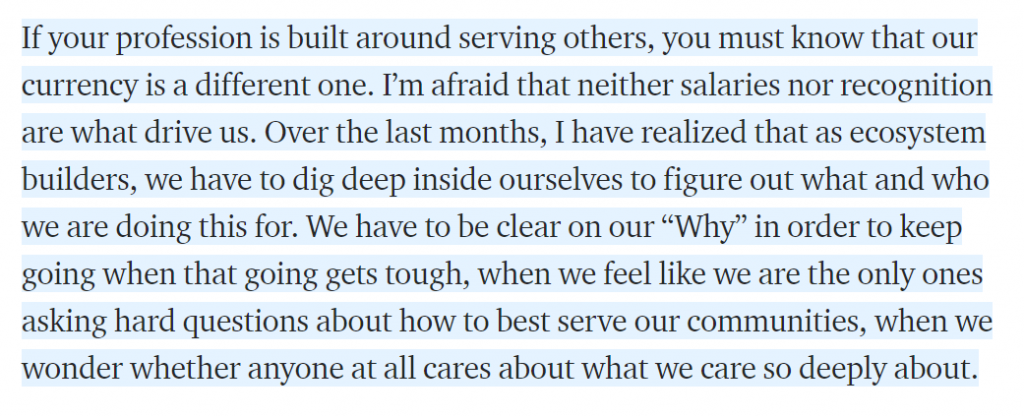There are leaders and there are those who lead.
I had heard the quote before but it wasn’t until I picked up “Start with Why” by Simon Sinek that I started to appreciate the nuance of what it takes to get others so excited about our cause to the point of willingly and happily following along. Not least because I never considered myself a charismatic leader. I’m good at executing – knowing HOW to get things into the world – but in my past, I was rarely the one who charged forward with a mission rallying the troops behind me.
In “Start with Why”, Simon Sinek introduces the Golden Circle that looks something like this:

- The WHAT is the product or service you are selling, the certain job or function you fulfill in the system.
- The HOW reflects the way in which you get things done that sets you apart from others; you might call it your “differentiating value proposition, proprietary process or unique selling proposition” (chapter 3)
- The WHY is your purpose, cause or belief: WHY do you get out of bed in the morning? WHY should anyone care?
Simon Sinek argues that most companies and people start by talking about WHAT they do and – if they haven’t lost their audience’s interest yet – move on to talk about HOW they’re different before finally getting to WHY they even make a product or service in the first place.
When in fact, we should be communicating in the reverse order.
The Power of Purpose for changemakers
As changemakers we set out with an irrefutable desire to create social and/or environmental impact. The challenge we see in the world and that most deserves our attention will enrage us over breakfast, pull us into heated debates throughout the day and lead us down many rabbit holes before resting our head on a pillow at night, tossing and turning wondering what we might do about any of it. Many of us have been unable to shake this desire that fuels our life’s work and, hence, we find ourselves in many different roles trying to create the change we hope to see.
The fire in your life’s work
Clearly, there are various ways to bring our desire for change into the world. We might join an organization fighting for “our” cause. We might find volunteer opportunities or even part-time work to further our passion. Some of us take it even farther and launch our own organization to take matters into our own hands, and some of us find ourselves in the role of ecosystem builders to help create and accelerate systemic change by connecting people and resources as efficiently as possible.
Subconsciously or not, we all start out with a WHY, fueled by our desire for change to contribute to a world that we want to live in.
Once we have found an outlet for our changemaking desire, we roll up our sleeves and get to work. In the day to day of the work that passion ignited in us, we start to feel the realities of raising funds and trying to market our cause in an already noisy world. We might start to experience that most roles in a social impact ecosystem don’t pay all that well. We might learn that rallying all stakeholders in an ecosystem around the same goal is harder than we imagined. Before we know it, we find ourselves exposed to the trials and tribulations of trying to lead by example.
In brief: You start with WHY and a heart full of hope and ambition, and as you begin to dive into the work, you start to drift. Certain performance metrics pull us in one direction, other people’s behavior in another. And a few years into our journey as a changemaker, we might wake up tired and exhausted and wonder how we got so close to burning out. Should we just get a “real job”?
Your HOW and WHAT might change, your WHY remains.
Based on 50+ interviews with changemakers who believe in the power of entrepreneurship for social change, I learned that the most pressing tasks awaiting organizational leaders, their teams and the self-employed include (and are not limited to)
- Managing operations of an organization,
- Leading a team and nurturing the right culture,
- Hiring and letting go of people,
- Reporting to a Board,
- Managing contracts,
- Recruiting partners,
- Raising funds,
- Assessing your impact,
- Product development,
- Planning for succession, and
- Never-ending administrative tasks.
Trying to accomplish these day-to-day responsibilities might mean you take your eye off your big vision for a bit – not a bad thing per se if you are trying to get things done and move the rock of social change up your Sysyphean mountain. But we owe it to ourselves to check back in with our driving force, our raison d’etre, or WHY, on a regular basis and assess whether HOW we do our work and WHAT we produce as an outcome is still in line with the circumstances we live in and the skills, experiences and interests we have gained over the years.
As Simon Sinek says:
Your HOW and WHAT might change, your WHY remains as you move through your career, change jobs, gain new skills and interests.
Simon Sinek, Start with Why, ch. 3
Banner Image Credit: Photo by Jordan Madrid on Unsplash

